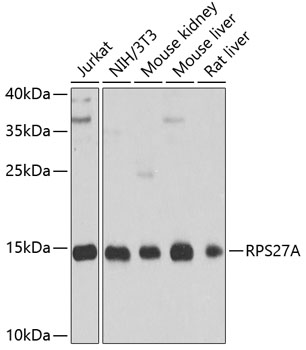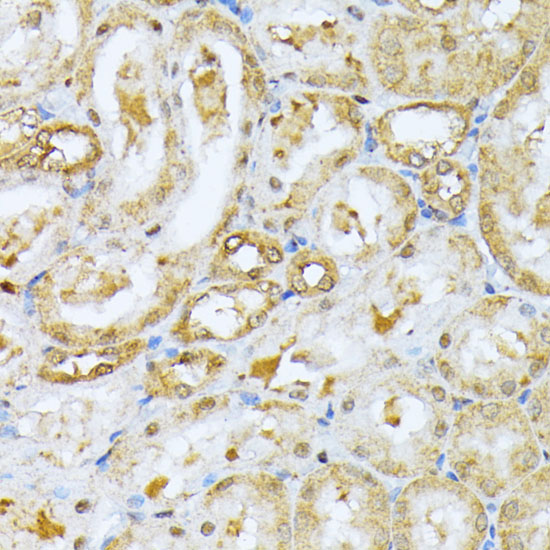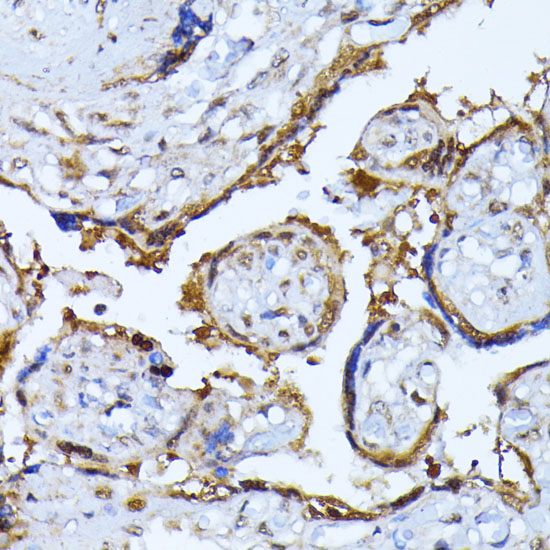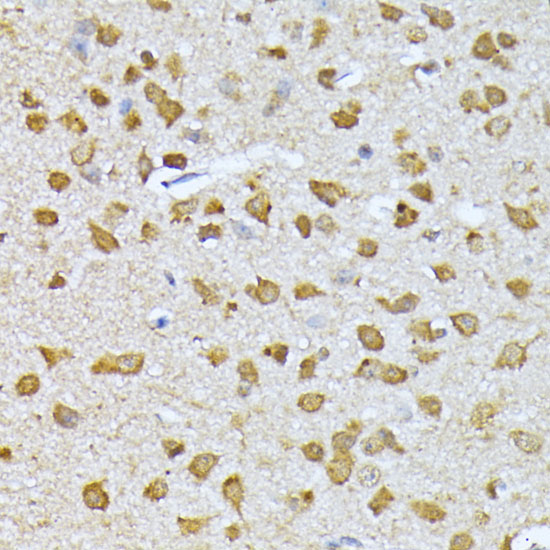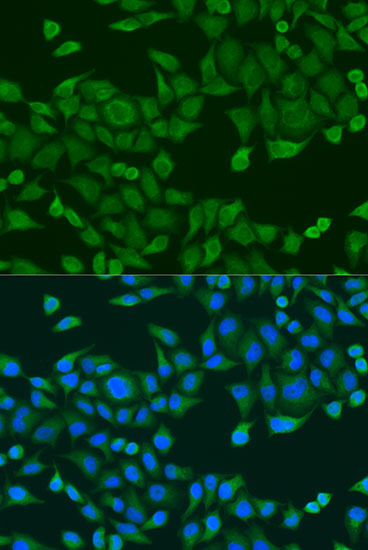Cell Biology Antibodies 8
Anti-RPS27A Antibody (CAB2027)
- SKU:
- CAB2027
- Product Type:
- Antibody
- Reactivity:
- Human
- Reactivity:
- Mouse
- Reactivity:
- Rat
- Host Species:
- Rabbit
- Isotype:
- IgG
- Research Area:
- Cell Biology
Description
| Antibody Name: | Anti-RPS27A Antibody |
| Antibody SKU: | CAB2027 |
| Antibody Size: | 20uL, 50uL, 100uL |
| Application: | WB IHC IF |
| Reactivity: | Human, Mouse, Rat |
| Host Species: | Rabbit |
| Immunogen: | Recombinant fusion protein containing a sequence corresponding to amino acids 1-156 of human RPS27A (NP_001170884.1). |
| Application: | WB IHC IF |
| Recommended Dilution: | WB 1:500 - 1:2000 IHC 1:50 - 1:200 IF 1:50 - 1:200 |
| Reactivity: | Human, Mouse, Rat |
| Positive Samples: | Jurkat, NIH/3T3, Mouse kidney, Mouse liver, Rat liver |
| Immunogen: | Recombinant fusion protein containing a sequence corresponding to amino acids 1-156 of human RPS27A (NP_001170884.1). |
| Purification Method: | Affinity purification |
| Storage Buffer: | Store at -20'C. Avoid freeze / thaw cycles. Buffer: PBS with 0.02% sodium azide, 50% glycerol, pH7.3. |
| Isotype: | IgG |
| Sequence: | MQIF VKTL TGKT ITLE VEPS DTIE NVKA KIQD KEGI PPDQ QRLI FAGK QLED GRTL SDYN IQKE STLH LVLR LRGG AKKR KKKS YTTP KKNK HKRK KVKL AVLK YYKV DENG KISR LRRE CPSD ECGA GVFM ASHF DRHY CGKC CLTY CFNK PEDK |
| Gene ID: | 6233 |
| Uniprot: | P62979 |
| Cellular Location: | Cytoplasm, Nucleus |
| Calculated MW: | 17kDa |
| Observed MW: | 14kDa |
| Synonyms: | RPS27A, CEP80, HEL112, S27A, UBA80, UBC, UBCEP1, UBCEP80 |
| Background: | Ubiquitin, a highly conserved protein that has a major role in targeting cellular proteins for degradation by the 26S proteosome, is synthesized as a precursor protein consisting of either polyubiquitin chains or a single ubiquitin fused to an unrelated protein. This gene encodes a fusion protein consisting of ubiquitin at the N terminus and ribosomal protein S27a at the C terminus. When expressed in yeast, the protein is post-translationally processed, generating free ubiquitin monomer and ribosomal protein S27a. Ribosomal protein S27a is a component of the 40S subunit of the ribosome and belongs to the S27AE family of ribosomal proteins. It contains C4-type zinc finger domains and is located in the cytoplasm. Pseudogenes derived from this gene are present in the genome. As with ribosomal protein S27a, ribosomal protein L40 is also synthesized as a fusion protein with ubiquitin; similarly, ribosomal protein S30 is synthesized as a fusion protein with the ubiquitin-like protein fubi. Multiple alternatively spliced transcript variants that encode the same proteins have been identified. |
| UniProt Protein Function: | RPS27A: the gene (RPS27A) that encodes this protein is one of four that encode for ubiquitin: UBC, UBB, UBA52 and RPS27A. UBB and UBC genes code for a polyubiquitin precursor with exact head to tail repeats, the number of repeats differ between species and strains. UBA52 and RPS27A genes code for a single copy of ubiquitin fused to the ribosomal proteins L40 and S27a, respectively. The RPS27A gene product is cleaved into the following 2 chains: ubiquitin (amino acids 1-76) and the 40S ribosomal protein S27a (amino acids 77-156). Ubiquitin is a peptide 76 amino acids in length that can be covalently attached to target lysines either as a monomer or as a lysine-linked polymer. Hundreds of ubiquitin ligases and hydrolases have been identified, implicating ubiquitin as a major regulatory element in many crucial cellular systems. It can be covalently bound to target proteins via an isopeptide bond either as a monomer (monoubiquitin), a polymer linked via different Lys residues of the ubiquitin (polyubiquitin chains) or a linear polymer linked via the initiator Met of the ubiquitin (linear polyubiquitin chains). Polyubiquitin chains, when attached to a target protein, have different functions depending on the Lys residue of the ubiquitin that is linked: Lys-6-linked may be involved in DNA repair; Lys-11-linked is involved in ERAD (endoplasmic reticulum-associated degradation) and in cell-cycle regulation; Lys-29-linked is involved in lysosomal degradation; Lys-33-linked is involved in kinase modification; Lys-48-linked is involved in protein degradation via the proteasome; Lys-63-linked is involved in endocytosis, DNA-damage responses as well as in signaling processes leading to activation of the transcription factor NF-kappa-B. Linear polymer chains formed via attachment by the initiator Met lead to cell signaling. Ubiquitin is usually conjugated to Lys residues of target proteins, however, in rare cases, conjugation to Cys or Ser residues has been observed. When polyubiquitin is free (unanchored-polyubiquitin), it also has distinct roles, such as in activation of protein kinases, and in signaling. At the protein level, it is not possible to easily determine which of the four genes encoded a given ubiquitin chain. |
| UniProt Protein Details: | Protein type:Ribosomal; Ubiquitin-like modifier Chromosomal Location of Human Ortholog: 2p16 Cellular Component: nucleoplasm; small ribosomal subunit; membrane; cytoplasm; nucleolus; plasma membrane; endosome membrane; cytosol Molecular Function:structural constituent of ribosome; metal ion binding Biological Process: circadian rhythm; I-kappaB kinase/NF-kappaB cascade; SRP-dependent cotranslational protein targeting to membrane; negative regulation of ubiquitin-protein ligase activity during mitotic cell cycle; protein polyubiquitination; nerve growth factor receptor signaling pathway; viral reproduction; positive regulation of apoptosis; activation of MAPK activity; stress-activated MAPK cascade; toll-like receptor 3 signaling pathway; endosome transport; DNA damage response, signal transduction by p53 class mediator resulting in cell cycle arrest; T cell receptor signaling pathway; activation of NF-kappaB transcription factor; toll-like receptor 5 signaling pathway; regulation of apoptosis; antigen processing and presentation of peptide antigen via MHC class I; transforming growth factor beta receptor signaling pathway; translational initiation; JNK cascade; antigen processing and presentation of exogenous peptide antigen via MHC class I; viral transcription; G2/M transition of mitotic cell cycle; toll-like receptor 4 signaling pathway; regulation of interferon type I production; glycogen biosynthetic process; positive regulation of I-kappaB kinase/NF-kappaB cascade; fibroblast growth factor receptor signaling pathway; transcription, DNA-dependent; Notch receptor processing; glucose metabolic process; antigen processing and presentation of exogenous peptide antigen via MHC class I, TAP-dependent; virus assembly; toll-like receptor 2 signaling pathway; translational elongation; carbohydrate metabolic process; mRNA catabolic process, nonsense-mediated decay; viral protein processing; positive regulation of transcription from RNA polymerase II promoter; toll-like receptor 9 signaling pathway; negative regulation of interferon type I production; negative regulation of apoptosis; G1/S transition of mitotic cell cycle; positive regulation of ubiquitin-protein ligase activity during mitotic cell cycle; negative regulation of epidermal growth factor receptor signaling pathway; translation; apoptosis; pathogenesis; viral infectious cycle; negative regulation of transcription from RNA polymerase II promoter; translational termination; toll-like receptor 10 signaling pathway; anaphase-promoting complex-dependent proteasomal ubiquitin-dependent protein catabolic process; positive regulation of interferon type I production; transmembrane transport; epidermal growth factor receptor signaling pathway; transcription initiation from RNA polymerase II promoter; Notch signaling pathway; MyD88-independent toll-like receptor signaling pathway; cytokine and chemokine mediated signaling pathway; DNA repair; MyD88-dependent toll-like receptor signaling pathway; cellular protein metabolic process; regulation of ubiquitin-protein ligase activity during mitotic cell cycle; toll-like receptor signaling pathway; innate immune response; gene expression; mitotic cell cycle; negative regulation of transforming growth factor beta receptor signaling pathway |
| NCBI Summary: | Ubiquitin, a highly conserved protein that has a major role in targeting cellular proteins for degradation by the 26S proteosome, is synthesized as a precursor protein consisting of either polyubiquitin chains or a single ubiquitin fused to an unrelated protein. This gene encodes a fusion protein consisting of ubiquitin at the N terminus and ribosomal protein S27a at the C terminus. When expressed in yeast, the protein is post-translationally processed, generating free ubiquitin monomer and ribosomal protein S27a. Ribosomal protein S27a is a component of the 40S subunit of the ribosome and belongs to the S27AE family of ribosomal proteins. It contains C4-type zinc finger domains and is located in the cytoplasm. Pseudogenes derived from this gene are present in the genome. As with ribosomal protein S27a, ribosomal protein L40 is also synthesized as a fusion protein with ubiquitin; similarly, ribosomal protein S30 is synthesized as a fusion protein with the ubiquitin-like protein fubi. Multiple alternatively spliced transcript variants that encode the same proteins have been identified.[provided by RefSeq, Sep 2008] |
| UniProt Code: | P62979 |
| NCBI GenInfo Identifier: | 302393745 |
| NCBI Gene ID: | 6233 |
| NCBI Accession: | P62979.2 |
| UniProt Related Accession: | P62979 |
| Molecular Weight: | |
| NCBI Full Name: | Ubiquitin-40S ribosomal protein S27a |
| NCBI Synonym Full Names: | ribosomal protein S27a |
| NCBI Official Symbol: | RPS27A |
| NCBI Official Synonym Symbols: | UBC; S27A; CEP80; UBA80; HEL112; UBCEP1; UBCEP80 |
| NCBI Protein Information: | ubiquitin-40S ribosomal protein S27a |
| UniProt Protein Name: | Ubiquitin-40S ribosomal protein S27a |
| UniProt Synonym Protein Names: | Ubiquitin carboxyl extension protein 80Cleaved into the following 2 chains:Ubiquitin; 40S ribosomal protein S27a |
| Protein Family: | 40S ribosomal protein |
| UniProt Gene Name: | RPS27A |
| UniProt Entry Name: | RS27A_HUMAN |


